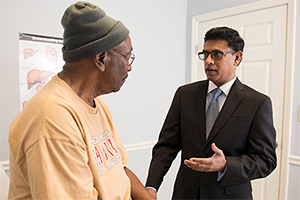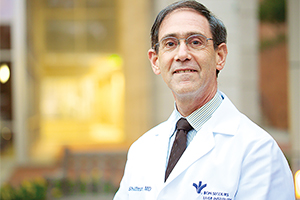By JULIE MINDA
Medication therapies are hitting the market that can cure Hepatitis C in the vast majority of patients — and with fewer side effects and treatment risks, as compared with past therapies. But significant numbers of those who are infected and who could benefit from the new treatments are unable to access the medications because of their high costs and an unwillingness of insurance carriers to pay these costs for many patients with Hepatitis C, according to Dr. Mitchell Shiffman, director of the Liver Institute of Virginia, part of Bon Secours Virginia Health System.
"We have the ability to wipe out Hepatitis C in 10 years, but we can't do that if we can't get patients treated," said Shiffman. The Liver Institute has locations in Richmond and Hampton Roads, Va.

Dr. Ravi Ravinuthala, medical director of the Mercy Health Liver Center at The Jewish Hospital, meets with Truman Holmes. Holmes was cured of Hepatitus C through drug treatments supervised by Ravinuthala.
Shiffman said it's important for the ministry to lead the way in raising public awareness about barriers to medication access and in advocating for better access. "Catholic health systems are very good at speaking up for those who can't speak for themselves when obvious inequities exist. And so raising this issue would be something that we can do," he said. He noted that improving access to Hepatitis C cures has implications for mitigating ethnic disparities in health care treatment. The viral infection is "more common in African Americans, and Hispanics, than in Caucasians," he said.
A study by Centers for Disease Control researchers published in the January 2013 American Journal of Public Health found minority status, low household income and lack of health insurance played a significant role in low rates of Hepatitis C testing in at-risk individuals and treatment rates of patients with Hepatitis C infection.
Treatment breakthrough
Hepatitis C is caused by a virus transmitted through the blood of infected people, according to the CDC. This transmission most commonly happens through the sharing of needles, including from illegal drug use, needlesticks in health care settings and potentially from tattooing when poor infection-control practices are used. Prior to 1992, when the U.S. began screening the blood supply for Hepatitis C, the virus also was commonly spread through blood transfusions and organ transplants. The CDC estimates 3.2 million Americans are infected with Hepatitis C.
Hepatitis C is a liver inflammation that, left untreated, can turn into a chronic infection marked by the presence of the virus in the blood for upwards of 75 percent of infected individuals. It will cause chronic liver disease marked by damage to the liver for upwards of 60 percent of untreated individuals. It can lead to cirrhosis for more than 5 percent of them, the CDC said. Hepatitis C was listed as the cause of death for more than 16,600 people in 2010, the most recent year for which the CDC provides mortality data for the disease on its website.
Until about a year ago, the predominant treatment for Hepatitis C was a series of interferon injections — usually one injection per week for 12 to 48 weeks — in combination with ribavirin pills administered over the course of months (with the number of months dependent on the level of liver damage). Interferon is a protein produced by the body to fight infection by boosting immune response; and ribavirin is a drug that combats viral infection. This two-drug protocol commonly causes fatigue, flulike symptoms, mild anxiety, skin rashes, depression and nausea, but it cures patients in up to 60 percent of cases, according to Shiffman.
In December 2013, pharmaceutical company Gilead Sciences brought to the market a drug called Sovaldi that — used alone or in combination with ribavirin and/or interferon — has a 90 percent-plus cure rate, a shorter treatment time and fewer side effects. It is administered daily over eight, 12 or 24 weeks, depending on a patient's prognosis prior to treatment. A new Gilead drug introduced in October, Harvoni, has a slightly better cure rate and eliminates the need for ribavirin and for interferon injections.

Shiffman
Shiffman explained that successful treatment of Hepatitis C eliminates the virus, and "once the virus is gone the irritation the virus is causing within the liver resolves. As irritation resolves, so does scarring." He added that cirrhosis also is reversible as long as there is not too much scarring. Shiffman noted patients who are cured of Hepatitis C also commonly see decreased scarring afterwards. About half no longer have cirrhosis five years post-cure.
"The point of no reversal is not known. Patients with severe advanced cirrhosis and reduced liver function can stabilize and improve once Hepatitis C is cured. However overt liver failure is not reversible," he said.
Additional companies beyond Gilead have other Hepatitis C drugs in various stages of development that could have similar cure rates and protocol improvements, according to Dr. Ravi Ravinuthala, medical director of the Kenwood, Ohio-based Mercy Health Liver Center at The Jewish Hospital, part of Mercy Health.
The new drugs coming on the market "change the whole outcome for our patients dramatically," said Ravinuthala.
High price tag
Despite the promise of the new protocols, both Shiffman and Ravinuthala estimate that only about half of their patients who could benefit from the available therapies and have applied for insurance preauthorization have gotten it. Shiffman said insurers have put in place strict criteria to qualify patients to receive the treatments. Sovaldi costs $1,000 per pill and Harvoni $1,125 per pill, so the cost of treating a patient taking one pill per day for eight weeks would approach $66,000; Shiffman said many payers are balking at the cost.
Eligibility guidelines for Hepatitis C drugs can vary greatly by commercial insurer, and by plan administrators in the case of Medicare, and by state in the case of Medicaid; but Shiffman said it is common for payers to limit the drug coverage to people with level 3 or 4 liver damage, as confirmed by a biopsy. (Liver damage commonly is scored on a "0" to "4" scale, with 4 being the most severe and including cirrhosis.) Shiffman said he's found few exceptions to this rule in his practice. Ravinuthala said he's seen some success in getting approvals for some people with lower levels of liver damage, but he said it's far more likely to get the approvals for people with more extensive damage.
Waiting game
Shiffman and Ravinuthala said their staffs do all they can to try to help patients get insurance approval for the new drug therapy, submitting paperwork, making phone calls responding to payers' requests for more information, and working through cumbersome appeals processes.
Shiffman said his patients with low scarring scores usually are denied even after appeals. "Most are choosing to wait it out," and planning to return in several years when the scarring may have progressed to the point where they would be approved for the therapy.
Ravinuthala said for his patients who have been denied for one therapy, his office tries to help them apply for new therapies as they come on the market. For instance, his office helped some patients denied Sovaldi to successfully apply for Harvoni. For some denied insurance preauthorization, Ravinuthala can point them to the clinical research arm of the Ohio Gastroenterology and Liver Institute. Ravinuthala is part of that private medical practice. The institute offers free medication and treatment to the limited group of patients who meet the stringent criteria to enter a clinical trial.
Ravinuthala said the Mercy Health Liver Center and its affiliated specialty pharmacy also are doing what they can to help patients navigate programs Gilead offers to low-income and/or uninsured patients. One such program assists low-income people with co-pays.
Risky delay
With new Hepatitis C drugs from multiple companies set to hit the market in coming years, prices may drop and access restrictions may loosen, agreed Shiffman and Ravinuthala. But until then, both doctors say restricting access to cures for patients with low levels of scarring is dangerous.
"They could develop advanced liver disease which could lead to complications — it's a slippery slope where the main worry is that the livers may fail while the patients are waiting," said Ravinuthala.
Shiffman said allowing liver disease to progress could increase patients' likelihood of contracting kidney disease, diabetes and some forms of cancer. "If insurance companies would factor in (the potential cost of treating) all those things," they would realize that treating Hepatitis C early, though costly, could prevent patients from incurring much higher costs for other conditions later.
Shiffman said treating Hepatitis C early could have broad impact, including freeing up significant numbers of spots on the liver transplant waiting list and drastically reducing the incidence of liver cancer. "We have the tools to have an enormous impact in patients' lives, but if they can't get the treatment … we can't do that," Shiffman said.
| Most people with acute Hepatitis C unaware they have the virus
The Centers for Disease Control and Prevention says between 70 percent and 80 percent of those with acute Hepatitis C do not have symptoms, but soon after infection some people do experience fatigue, nausea, loss of appetite, joint pain and abdominal pain. Since most Hepatitis C sufferers are asymptomatic, the CDC recommends testing for the condition for people who may have been exposed to infected blood and for people who were born between 1945 and 1965. According to information from the CDC, Baby Boomers are five times more likely to have Hepatitis C, than adults in other generations. According to WebMD, it is not known why Hepatitis C is more prevalent in the Baby Boom generation. Currently, the highest reported age-specific incidence of acute Hepatitis C in the U.S. is among people aged 20 to 29 years, whereas prior to 2001, most U.S. reports of acute Hepatitis C occurred among people aged 30 to 49 years. This is according to the CDC, which notes that there is an "emerging epidemic" of Hepatitis C infection among young people who inject drugs. A Hepatitis C resource from the C. Everett Koop Institute says the top risk factors associated with acute Hepatitis C infection in the U.S. are: having low socioeconomic status (44 percent), having participated in intravenous drug use (38 percent) and having had sexual contact with or been in the same household with someone who was affected (10 percent). |
Copyright © 2014 by the Catholic Health Association
of the United States
For reprint permission, contact Betty Crosby or call (314) 253-3477.